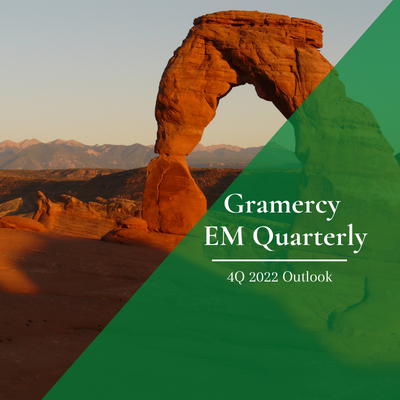Authored by:
Robert Koenigsberger, Managing Partner & Chief Investment Officer
Mohamed A. El-Erian, Chair
Petar Atanasov, Director & Co-Head of Sovereign Research
Kathryn Exum, Director & Co-Head of Sovereign Research
October 5, 2022
Decoding the Global Macro Environment: A Top-down Perspective and the Related Implications for Emerging Markets Heading into 4Q 2022
A difficult third quarter for global financial markets serves as a reminder that the global economy and markets are on a bumpy journey to a new destination. It did not help that the inherently-volatile nature of this journey – triggered by a fundamental change in the characterization of the global economy from being demand constrained to toiling under supply constraints – is being amplified by major central banks scrambling to catch up with inflation realities at a time of slowing global growth. It also did not seem to matter much that this is a journey to a less distorted financial system and sounder risk taking.
The markets’ romance at the start of the quarter with an early and orderly “pivot” by the Federal Reserve proved short-lived in the face of a persistent rise in measures of core inflation and, associated with this, a now more consistently hawkish tone from Fed officials. The resulting tightening of financial conditions coincided with evidence that the three most systemically economic areas in the world (China, the Eurozone and the United States) were slowing at a faster rate than consensus expectations. Meanwhile, buoyed by favorable interest rate and growth differentials, as well as its relative safe haven status, the dollar embarked on a seemingly endless general appreciation.
It should come as no surprise that these “global common factors” translated in the dreaded trifecta for investors of negative returns, unsettling volatility, and a breakdown in asset class correlations in a manner that seriously undermined portfolio risk mitigations. More surprising is that the prime example of instability-fueling policy responses was not limited to the traditional small handful of emerging economies. It also extended to the United Kingdom where the surprise announcement of large unfunded tax cuts delivered wild currency and yield fluctuations, a reprimand from the International Monetary Fund, and disruptions to the domestic mortgage market.
Despite several cases of countries with solid fundamentals and timely policy responses, the vast majority of emerging markets got caught up in the market selloff driven by the trifecta of interest rate risk, credit risk, and liquidity risk. Also, and not surprisingly given the global macro drivers, veteran EM investors saw the asset class return to downward valuation overshoots that were particularly notable for the strongest names, and insufficient differentiation among both sovereigns and corporates. Fortunately, and notwithstanding a handful of individual cases, neither has proven bad enough to tip the asset class into debt stress.
Looking forward, it is hard to imagine an immediate lifting of the global growth, policy and liquidity clouds. The same goes for geo-political uncertainties, the impact of which has also been to contribute to changing globalization. As such, the analytical focus remains centered for now on the continuation of a bumpy journey to a better destination. It is a process in which markets, with time, should better differentiate between credits, thereby providing attractive investment opportunities for long-term investors.
Themes Influencing Investment Decisions in 4Q 2022
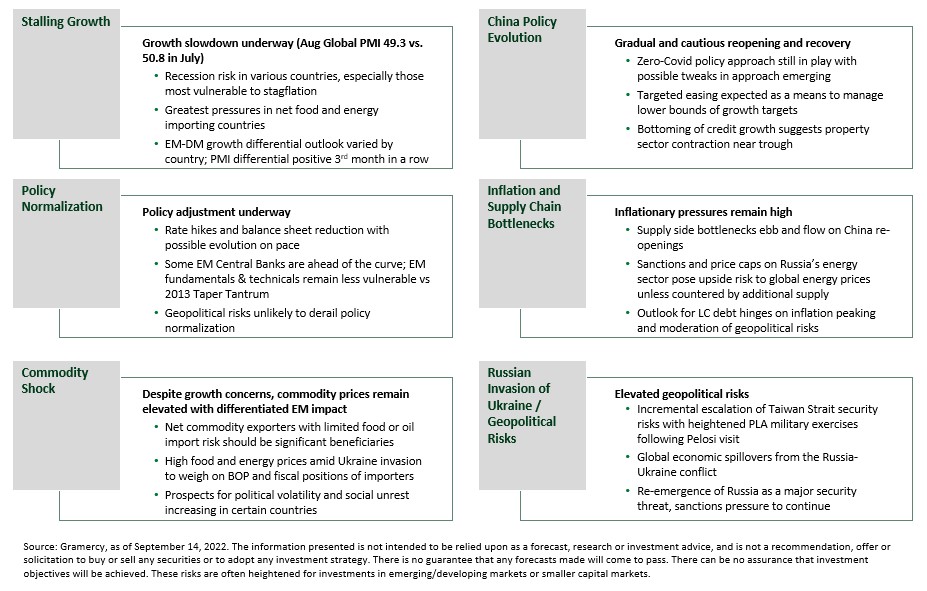
Turbulent global growth
The global growth slowdown extended in 3Q on continued tightening of global financial conditions in the backdrop of persistent and sticky inflation. Global PMI dipped into contractionary territory in August, most recently led by the U.S. and Europe. In China, high frequency data also moderated and remained mixed after a solid rebound in June on relaxation of virus-related restrictions. As highlighted in our last report, net commodity exporters with low linkages to CIS and Europe, largely in Latin America and Africa, have had more resilient growth dynamics with net commodity importers facing the greatest headwinds. From a sector perspective, industrial and goods sectors, particularly in Asia, remained more pressured while services sectors continued to benefit from recovery.
Looking forward to the coming quarter, we believe risks to global activity are elevated through year-end. This is due to a still weak Chinese economy subject to zero-COVID policy (“ZCP”) and a struggling property sector combined with significant energy pressures in Europe, and major central banks which continue to battle inflation. Deepening of European gas and power crises, despite some recent offsetting measures, will weigh on regional activity as well as fuel importers globally, notably in Asia, as demand destruction and loss of company competitiveness sets-in.
However, there are still signs of resilience with solid corporate balance sheets and elevated savings levels, particularly in the U.S. which is better positioned for the gas crunch. Additionally, China’s Party Congress to be held the week of October 16th could lay groundwork for resolution in the housing market and set the stage for a more durable recovery over the medium-term. While Chinese growth this year is now likely to be 3% or below given the expectation for rolling lockdowns through the winter, we see prospects for a gradual move to ‘living with COVID’ in 2023 which should begin more durable support momentum.
Exhibit 1: Bumpy road for global growth but prospects for better EM-DM differential into 2023
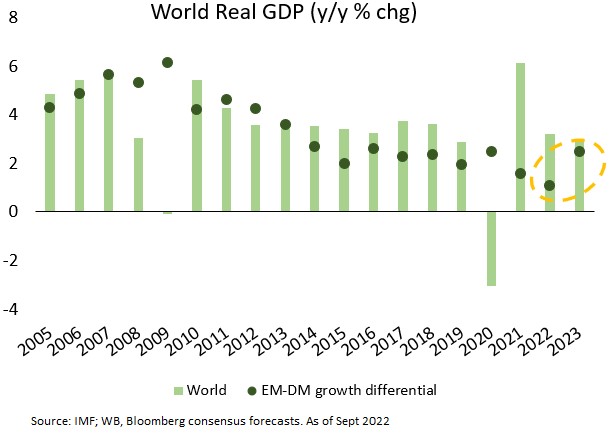
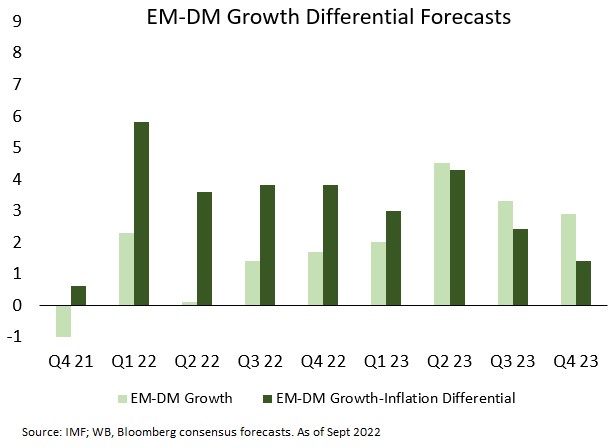
Still elevated Inflation risks anchor hawkish policy bias
Bruised from the consecutive shocks of the global pandemic and the war in Ukraine, the global economy continues to face elevated inflationary risks as we head into the last quarter of 2022. In our view, the supply side “bottlenecks” that we’ve highlighted in prior reports continue to linger as Chinese authorities remain committed to pursuing zero-COVID policies amid reluctance to rely on the effective western vaccines and the conflict in Ukraine rages on without prospects for near-term resolution.
In addition, it has become increasingly clear during 3Q that Russia intends to use its position of energy dominance over many European countries as a focal point of its geopolitical tussle with NATO and the collective West in general. As part of the Kremlin’s “energy war” against Europe, we expect that Russian gas supplies to the continent will continue to be severely curtailed and potentially even completely interrupted for periods of time as illustrated by the recent allegations of sabotage against the Nord Stream 1 pipeline. These tactics have already wreaked havoc on Europe’s energy markets where gas prices have increased dramatically compared to last year. As we approach the colder months in the Northern hemisphere when gas demand is set to spike, risks of energy shortages in some countries are not negligible and will likely keep broad-based price pressures elevated in those economies. Unless Europe is able to secure sufficient alternative gas supplies on time for the upcoming winter, energy rationing for households and industries could be on the table. Beside the inflationary impact, such dynamics could have important implications from a domestic political and fiscal standpoint. Importantly, they could provide renewed tailwinds for economic and social populism, with important market implications in the coming months.
TINA has faded, beware the FHL
In the years since the global financial crisis, global financial markets became accustomed to operating within a so-called “TINA” paradigm: There Is No Alternative as extraordinarily accommodative monetary policies globally kept the cost of money at historically low levels and pushed liquidity toward riskier assets. Amid the ongoing inflationary shock discussed in the previous section and arguably the belated reaction by the systemically important central banks, a new reality has started to emerge for global investors: FHL (“Faster, Higher and for Longer”). The acronym reflects what we expect to be the Fed’s and other major central banks’ policy response in order to put the inflation problem that their respective economies are facing under control.
As flagged in previous editions of this report, the main risk of FHL would be over-tightening of global financial conditions that could lead to significant recessions in many DM and EM economies. We believe this is a risk that global central bankers have now become willing to tolerate in the context of the wise economic adage that macro stability is not everything, but without it you have nothing. We believe this focus on fighting inflation should continue to weaken the market’s long-held belief in the inevitable monetary policy backstop as policymakers across the global economy amplify the FHL message in 4Q22.
An FHL bias by developed economies has a number of important credit implications for emerging markets, including a strong U.S. dollar pressuring EM currency, depleting external liquidity buffers and complicating refinancing by sovereigns and corporates alike. Fortunately, policymakers in a large chunk of the investible EM universe have been highly pro-active in the current challenging environment, tightening monetary policy pre-emptively and delivering by and large a highly competent and credible policy response. Against that backdrop, meticulous credit quality differentiation based on deep bottom-up fundamental analysis will remain the focal point of our investment analysis as we continue to search for value amid a potentially volatile fourth quarter in EM.
Ukraine’s counteroffensive may usher in a new more dangerous phase in the war
In the 3Q Outlook, we expressed the view that Ukraine was likely to attempt to regain control over territories that have fallen under Russian occupation, which informed our expectations for a protracted conflict. As we write now looking ahead to 4Q, our expectation has turned into reality. Persistent, albeit sometimes slow to materialize, Western financial and military support has enabled Kyiv to start a counteroffensive against the Russian forces occupying territories in Eastern Ukraine.
These recent developments are highly significant as they mark the first sustained offensive effort by Ukraine seven months after the Russian invasion of the country began in late February. The success of the operations in the Kharkhiv theater (in the East of Ukraine) in which Russian resistance appears to have crumbled quickly have further exposed weaknesses in the Kremlin’s war machine and is likely to embolden Ukraine’s political and military leadership and its Western allies. We expect similar offensive operations by Ukraine to be launched in other occupied parts of the country. The West appears to remain unified in its resolve to defeat President Putin’s aspirations in Ukraine and unperturbed in its support for Kyiv despite Moscow’s “energy war” that has intensified during the past quarter.
This is undoubtedly positive for Ukraine’s morale. In the face of foreign aggression and now armed with sophisticated offensive weaponry provided by its Western allies, its military has demonstrated the ability to liberate occupied territories. However, it also likely opens-up a new and potentially more dangerous chapter in this conflict. On one hand, Ukraine’s leadership is likely to explore Russia’s weaknesses and press its advantage whenever and wherever possible, supported by the Ukrainian public’s strong opposition to any concessions to Russia. This is likely to prolong the conflict well beyond the end of 2022, in our view. On the other hand, as Russia suddenly finds itself on the defensive and a conventional military campaign in Ukraine starts to increasingly look like a failure to domestic audiences, political pressure on President Putin is likely to mount.
On September 30, President Putin signed documents proclaiming the annexation of four occupied Ukrainian regions: Donetsk, Luhansk, Zaporizhzhia, and Kherson to the Russian Federation following Kremlin-organized referenda unrecognized by most of the international community. The two houses of Russia’s parliament approved the treaties, ratifying them into law. In our view, these developments mark the “end of the beginning” in the Ukraine war and introduce a new, potentially more dangerous phase in which market risks emanating from the conflict might increase. Support for the war effort is strong on both sides, which carries significant escalation risks, especially if the Ukrainian leadership decides to respond to Putin’s move by intensifying its counteroffensive against the now annexed territories before winter conditions settle in. In this context, we expect that Moscow will inevitably resort to more frequent and open referencing to its nuclear capabilities to “defend” the annexed territories, periodically sending shivers through global markets. We believe that the risk of nuclear weapons being used in/on Ukraine remains low but could grow higher if the chain of events unleashed by the annexations and Ukraine’s momentum on the battlefield puts President Putin “in a corner” over the coming months. Amid an increasingly challenging situation to manage in Ukraine, we expect the Kremlin to intensify its “proxy wars” against Europe, mostly via energy policy in the hope to break the West’s resolve to maintain financial and military support for Ukraine. We think this is unlikely to happen, which anchors our expectation for a protracted military conflict with significant escalation risks in early 2023 when the weather conditions improve.
China Party Congress gateway for ZCP evolution
The 20th Party Congress of China’s Communist Party is set for the week of October 16th and will form a new group of leaders as well as adopt strategic visions to form the basis of more detailed policymaking over the next five years. We see President Xi’s third term as nearly certain, despite ongoing economic pressures. Premier Li Keqiang is likely to step-down after serving two terms, however, with a focus on who will replace him. While the event itself is not usually used for specific policymaking decisions, we see ZCP as a highly likely topic with political and economic incentives to begin to evolve the narrative and approach to associated regulations, paving the way for a more formal evolution of measures ahead of the National People’s Congress in March 2023. This, combined with more defined principles on what role the property sector will play in the economy as well as further progress on specific measures in the aftermath of the Congress, should help growth momentum beyond 4Q.
China’s developmental strategy will likely i) further support dual circulation and domestic demand, ii) incrementally reorient supply chains away from export-oriented sectors, iii) support research and development to pursue technological self-reliance, iv) support the modernization of agriculture to enhance rural development, and v) deepen common prosperity initiatives.
From a foreign relations perspective, the Party is likely to aim to strategically balance Western and non-Western interests as seen with the approach to Russia and the war in Ukraine. The latest meeting between Xi and Putin in late 3Q pointed to limitations on the relationship given continued lack of outright support for the invasion, despite Putin openly acknowledging China’s balanced position, questions and concerns on the war. We expect China to continue to play a relatively neutral role in the conflict and avoid triggering U.S. sanctions. More broadly, U.S.-China relations will remain challenged with discussion of the Taiwan Policy Act in Congress in 4Q as well as ongoing military exercises in the Taiwanese straight.
Investment Strategy Review and Outlook
The themes we have discussed in previous quarters continued to largely play out as expected, apart from interest rate risk being still more prominently featured than we would have expected back in the late spring. We believe the reason can be found in the fact that the market got ahead of itself after the July CPI and a combination of Jackson Hole, August CPI and September FOMC created a powerful opposing momentum which is currently playing out in full force.
As much as we believed one swallow doesn’t make a summer with respect to the July CPI, we think the market is currently very close to fully pricing in interest rate risk. We believe credit and liquidity risk, the other two most important factors to consider, have also markedly played-out since May and are much more reflected in valuations now.
For many developed and developing economies, the question is not if we see a recession soon, but when and how severe the recession will be. However, we believe the global recession coming our way is more likely be a short and shallow one rather than a deep income and balance sheet recession.
From our perspective, several EM issuers are well prepared to deal with such a scenario, especially EM corporate issuers which have the best fundamentals in the last 10 years, apart from the known offenders that are already trading at highly stressed levels and probably even better than some developed markets issuers (especially parts of Western Europe). While liquidity risk is more difficult to quantify, we are encouraged by the fact that we have had no market accidents so far, which suggests for now there will be fewer excesses in the financial system than some expected.
In any case, we expect a stabilization at or around current levels in our asset class which we believe could provide a very attractive entry point to increase exposure for expected outsized returns over 12-24 months. We acknowledge the bumpy flight/turbulence that may be ahead, but we believe the non-recoverable mistake here is to miss the flight altogether.
Exhibit 2: Emerging Markets Debt Drawdown Analysis
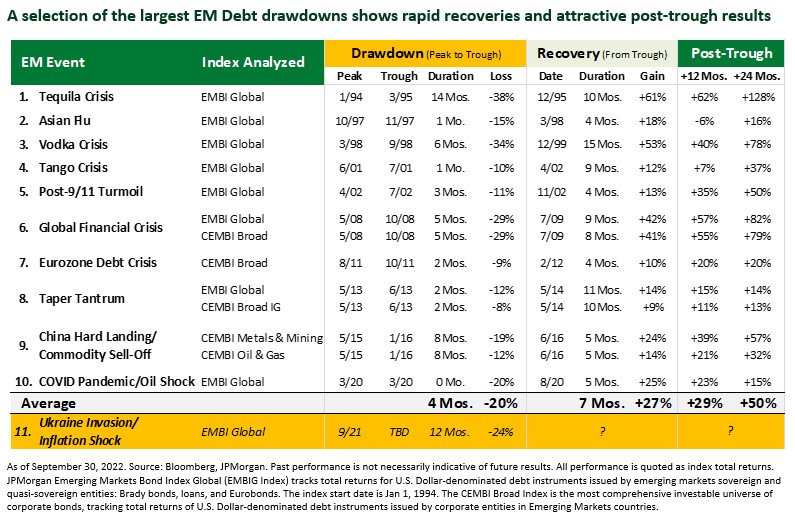
Exhibit 3: From a Top-down Perspective This is a Historic Drawdown
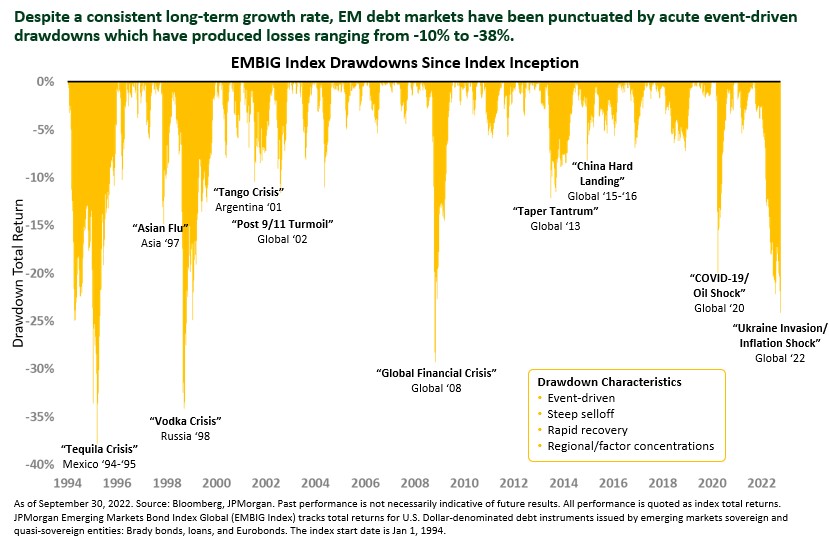
Multi-Asset
In our Multi-Asset Strategy, after initially preserving capital via return stream/issuer selection and a sizable cash position, we started to move towards a more neutral stance and are now putting our final cash holdings to work.
Our view seems to be increasingly shared by investors who have recently started to put capital to work in our long-only EM debt strategies. While we still like “contractual” return streams provided by our allocations to secured private credit and insured litigation finance, we have been allocating most of our uncommitted cash to attractively priced public credit.
We still prefer hard currency over local currency but see great opportunities in local currency into 2023 as soon as we experience the USD peaking. We still prefer corporates over sovereigns from a fundamental perspective but like certain stressed EM sovereign issuers from an opportunistic point of view given very appealing valuations vis-á-vis expected restructuring outcomes. We still like quality high yield corporates (“HY”) with attractive valuations but are now more leaning towards investing our cash into high quality long-end investment grade (“IG”) issuers having massive convexity after the recent UST selloff.
Emerging Markets Debt
Emerging markets year-to-date performance has been significantly impacted by the tightening of global financial conditions (U.S. 10-year Treasury wider by 195bps YTD and 89bps in 3Q) and general risk-off sentiment driven by a highly uncertain macro backdrop.
• Performance has also been impacted by idiosyncratic events such as Russia’s invasion of Ukraine in mid-February and China’s ongoing zero-COVID policy which continues to weigh on Chinese growth and the performance of the Chinese property sector.
• As we expected, and in-line with our positioning, corporates outperformed sovereigns (hard and local currency) and HY outperformed IG. HY corporates, driven by lower duration and solid fundamentals, posted the best performance YTD. Hard currency IG sovereigns, the EM sub-asset class with the highest duration, unsurprisingly performed the worst YTD.
• On a relative basis vs DM, EM IG corporates outperformed vs US IG and performed in line with EUR IG YTD. In contrast, EM HY corporates underperformed both US HY and EUR HY despite having less than half the leverage, suggesting that EM HY corporates are particularly penalized for being in the wrong zip code. (See Exhibit 4 for asset class return history).
Exhibit 4: Asset Class Returns

While the macro backdrop remains challenging, given the level of drawdown that has already taken place YTD, we remain cautiously constructive on EM debt. This year’s drawdown has surpassed the COVID drawdown to become the second largest in the last two decades. Historically, such drawdowns are followed by a period of significant recovery over the following 12-24 months. As such, we believe current levels provide a good entry point for investors wanting to participate in the upside. Nonetheless, active management is critical to manage the risks posed by the uncertain external environment.
• J.P. Morgan data shows that EM hard currency has already experienced significant outflows of more than $24bn cumulative YTD, which has surpassed the cumulative outflow of $17.4bn experienced in 2008. Similarly, EM local has experienced significant outflows of more than $26bn cumulative YTD, which has surpassed the cumulative outflows from 2015 of $15.3bn.
• We believe going into the second half of 2022, extremely compelling valuations and more supportive technicals should mitigate the potential for further outflows.
• EM corporate HY offers 86bps over U.S. HY (versus a 5-yr average of 48bps) and EM sovereign HY offers 365bps over U.S. HY (versus a 5-yr average of 144bps).
• We expect new issuance to remain depressed for the remainder of the year. Issuance YTD stands at only $256bn ($188bn from EM corporates and $68bn from sovereigns). 2022’s primary issuance forecast for EM is $383bn ($260bn corporate and $123bn sovereign). This is 47% below 2021 on a consolidated basis. Net financing expectations for 2022 have now turned negative, suggesting that the EM fixed income asset class is likely to shrink for the first time in two decades. For EM corporates, the market is likely to shrink by 8% this year alone due to these dynamics.
• From a fundamental perspective, EM corporates have the healthiest balance sheets in over 10 years, providing a significant buffer for navigating inflationary pressures and/or growth concerns. EM net leverage is 1-2x lower than comparable DM credits with EM corporate IG and HY net leverage of 1.0x and 2.1x, respectively (vs. 2.4x and 4.0x for U.S. IG and HY, respectively). Despite better fundamentals, EM corporates have been overly penalized for being in the wrong zip codes. As such, investors are currently paid 2.1x more to own EM HY vs U.S. HY and 3.0x more for EM IG vs U.S. IG.
• Sovereign fundamentals on the other hand are more dispersed than corporates because there has been a transfer of resources from public to private. As a result, sovereign debt burdens have grown heavier across the board with the extent of deterioration varying depending on the scale of measures implemented and their effectiveness. Pressure on some sovereign balance sheets has also grown on the back of the continuing Russia/Ukraine conflict and its impact on global commodities, while others have experienced some relief. Given these factors, a greater level of differentiation is needed for sovereigns.
• The coming quarter will be important from a global risk sentiment perspective as investors continue to navigate the push and pull between fears of continued high inflation and fears of a recession. The high level of uncertainty on the back of mixed global economic data, coupled with more hawkish central banks, is likely to keep risk sentiment muted; however, given the historic drawdown seen to date in our market, we believe risk is skewed to the right tail over the medium-to-long run.
• We retain our preference for EM corporates over sovereigns, HY over IG and hard-currency over local currency. We note that given the widening in rates, pockets of value are forming in IG, particularly in EM corporate IG, which are providing interesting opportunities for portfolio optimization.
Capital Solutions
The higher interest rate environment that characterized the third quarter did not slow down the momentum of private credit deployment. While the primary issuance in the public markets took a severe downturn, we believe private credit continues to offer compelling investment opportunities for our capital solutions team. The investment thesis has evolved over the last year. It went from a spread differential to public securities priced to perfection, to one of asymmetric returns based on cash plus equity-like upside with robust downside protection. This is the case because private credit remains one of the few alternatives to finance corporates medium and long-term business plans.
During the past couple of months, financing opportunities ranged from portfolios of credit card loans to the resurgence of the travel industry post COVID through airport concessions. Since the beginning of July, the capital solutions team closed five transactions and continues to see a robust pipeline.
Given the current market volatility and the effects of higher interest rates and inflation, our team has focused on adding more floating rate assets to the portfolio. All primary assets sourced during this last quarter have been structured as floating rate assets with the objective of having most of the portfolio be floating rate based. Furthermore, in this environment, the team has tightened our underwriting standards to further protect the downside by seeking, when possible, lower LTV’s and the addition of uncorrelated collateral.
Given the robustness of the pipeline, we expect to continue our deployment by funding attractive opportunities. These opportunities are constantly being tested for downside scenarios given market dynamics and structured with sound collateral packages in ways that allow us to fulfill our mandate.
Alternative Credit
In our Alternative Credit Strategy, we have been focused on the current dislocation in the market and triaging which assets are cheap relative to expected recoveries (distressed) as opposed to bonds that are just cheaper than they used to be. This past quarter, we have witnessed the impact of illiquidity on asset prices and are focused on areas where we think such dislocations don’t make fundamental sense. These areas include commodity producers with strong free cash flows who have enjoyed deleveraging due to higher commodity prices.
China property continues to be under stress. Weak home sales, tight regulation, recent COVID outbreaks and challenging financing conditions have driven prices to distressed levels, but we believe recoveries are likely to be substantially higher than some of the current levels suggest. Home sales are slowly improving driven by policy loosening and as financing conditions slowly improve for some select developers. Near-term catalysts include further improvement in home sales, the regulatory environment and financing conditions as well as full restructuring offers from Evergrande, which could provide some comfort to the market.
We are also quite intrigued by the dislocation in Republic of Argentina bonds that has taken bonds well below recovery values that we and others on the street believe will present themselves as we approach the 2023 elections/transfer of power. In the interim, we are encouraged by the appointment of Sergio Massa to “Super Minister” and believe he materially increases the probability of a muddle through until the upcoming elections.
Special Situations
The Special Situations Group continues to develop and execute on a robust pipeline of law firm financing opportunities. These opportunities are secured by large and diverse collateral pools of receivables from various genres of claims including environmental, consumer protection, medical device and other product failure claims. While the loan to collateral value is typically lower than other credit opportunities within the same jurisdiction, the return profile is still very attractive. The Special Situations Group is particularly focused on opportunities where the law firm and/or underlying case collateral has emerging markets (mainly Latin America) nexus, but the law firm is seeking recoveries in developed market jurisdictions including the U.S. and U.K.
In EM, the group has been focused on International Arbitration settlement in Argentina, insurance claim recoveries in Puerto Rico related to Hurricanes Maria and Irma and OFAC compliant litigation finance opportunities in Venezuela. Where possible, the Special Situations Group is utilizing insurance products for litigation finance and other investments, which creates an asymmetric risk return profile.
Conclusion
The journey thus far in 2022 has been bumpy indeed. That being said, clearer skies with high expected returns are visible in the horizon. Yes, the journey may be bumpy, but if proper security selection is employed (fastening of seat-belt) to respect the dispersion of outcomes that we expect, then the destination warrants the volatility. If history is any guide, waiting to identify the bottom may result in climbing the wall of worry and allocating closer to the top than the bottom a.k.a. “missing the flight.” As always, we have planned the trade and are trading the plan. All aboard!
About Gramercy
Gramercy is a dedicated emerging markets investment manager based in Greenwich, Connecticut with offices in London, Buenos Aires and Mexico City, and dedicated lending platforms in Mexico, Turkey, Peru, Pan-Africa, Brazil, and Colombia. The firm, founded in 1998, seeks to provide investors with attractive risk-adjusted returns through a comprehensive approach to emerging markets supported by a transparent and robust institutional platform. Gramercy offers alternative and long-only strategies across emerging markets asset classes including multi-asset, private credit, public credit, and special situations. Gramercy is a Registered Investment Adviser with the SEC and a Signatory of the Principles for Responsible Investment (PRI). Gramercy Ltd, an affiliate, is registered with the FCA.
Contact Information:
Gramercy Funds Management LLC
20 Dayton Ave
Greenwich, CT 06830
Phone: +1 203 552 1900
www.gramercy.com
Joe Griffin
Managing Director, Business Development
+1 203 552 1927
[email protected]
Investor Relations
[email protected]
This document is for informational purposes only, is not intended for public use or distribution and is for the sole use of the recipient. It is not intended as an offer or solicitation for the purchase or sale of any financial instruments or any investment interest in any fund or as an official confirmation of any transaction. The information contained herein, including all market prices, data and other information, are not warranted as to completeness or accuracy and are subject to change without notice at the sole and absolute discretion of Gramercy. This material is not intended to provide and should not be relied upon for accounting, tax, legal advice or investment recommendations. Certain statements made in this presentation are forward-looking and are subject to risks and uncertainties. The forward-looking statements made are based on our beliefs, assumptions and expectations of future performance, taking into account information currently available to us. Actual results could differ materially from the forward-looking statements made in this presentation. When we use the words “believe,” “expect,” “anticipate,” “plan,” “will,” “intend” or other similar expressions, we are identifying forward-looking statements. These statements are based on information available to Gramercy as of the date hereof; and Gramercy’s actual results or actions could differ materially from those stated or implied, due to risks and uncertainties associated with its business. Past performance is not necessarily indicative of future results. This presentation is strictly confidential and may not be reproduced or redistributed, in whole or in part, in any form or by any means. © 2022 Gramercy Funds Management LLC. All rights reserved.
